Brain Coral 101: Care, Types and Appearance, Fragging & More
Posted by on 12/16/2022
Fact checked by
We use affiliate links and may receive a small commission on purchases.
Brain Corals are some of the most fascinating organisms in the world’s oceans. With a life expectancy of over 800 years, these corals have been capturing the attention of humans since their discovery.
It’s no surprise that they’ve become a popular choice for reef aquarists, the color and appearance of brain corals make them a sight to behold. If you’re considering a brain coral for your reef tank, it’s important that you have a strong understanding of its care requirements.
In this guide, we’re going to cover it all - we’ll discuss the appearance of some of the most popular types, best practices with feeding, care, and much more.
January's Giveaways on Light Fish
Table of Contents
Species Summary
When reef aquarium hobbyists refer to brain corals, they are referring to any coral species that have a brain-like appearance.
This definition leaves a lot up to interpretation, but there are some genera that are more commonly referred to as brain corals. Lobophyllia, Scolymia, Trachyphyllia, Favites, and Platygyra, are some of the most common in the reef-keeping hobby, but there are dozens of additional genera. Most brain corals fall under the Merulinidae, Lobophylliidae, and Mussidae families, and are considered to be some of the most widespread large polyp stony (LPS) corals in the world’s oceans.
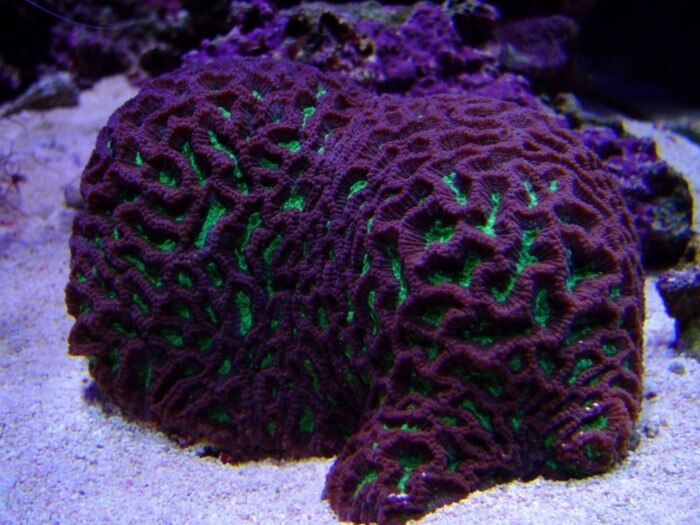
Size
Brain corals can grow to be quite large, in fact, some of the largest corals in the world are brain corals, such as the Toboggan boulder brain coral (scientific name: Colpophyllia natans), which stretches over 16 feet wide and 10 feet tall.
Most aquarists will own brain corals that are much smaller in size, typically corals will be sold when they’re between 1.5-4 inches wide. Brain corals that are a foot in width would be considered to be quite large.
Growth Rate
Brain corals that live in the world’s oceans are slow growers, growing about an inch per year, so it’s no surprise that you can expect similar results in a reef aquarium.
You can encourage growth by providing pristine water conditions and a nutrient-rich diet. While it’s safe to assume brain corals won’t take over your tank, some brain coral species such as those under the Favites genus, are capable of producing new heads every few months. Other species, like those that are under the Trachyphyllia genus, will only grow a few millimeters per year.
Appearance & Types
Corals are often sought after and priced based on their rarity and appearance, and the interesting shapes and colors produced by brain corals make them some of the most prized by reef aquarium hobbyists.
For the sake of brevity, we won’t discuss all of the brain coral genera, but you'll likely encounter the following species in your research.
Lobophyllia
You don’t have to be a neurosurgeon to appreciate the appearance of the Lobophyllia coral. Often referred to as the open-brain coral, these corals have high, rounded ridges, giving them a sculpted appearance.
Surfaces of Lobophyllia are typically quite smooth, but they can also be covered in small bumps and warts. Other Lobophyllia species may have papillae (short tentacles) along the ridges of the coral.
Tequila Sunrise Lobophyllia
Orange, green, and blue colored corals are occasionally referred to as Tequila Sunrise-colored corals, as is the case with this Lobophyllia. Even if you are not a fan of the alcoholic drink that inspired its name, you will likely be drawn to the vibrant colors of this coral when placed in a reef tank.
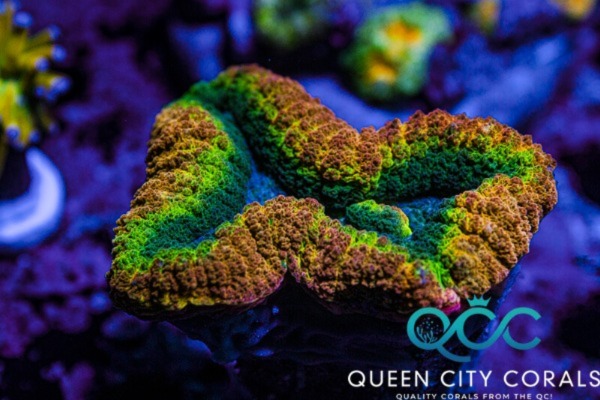
Bright Orange Lobophyllia
Lobophyllia corals are capable of producing brightly-colored orange ridges. Occasionally referred to as Ultra Orange Ring, or Bright Orange Orchard, the bright coloration of these Lobos make them a favorite among reef keepers.
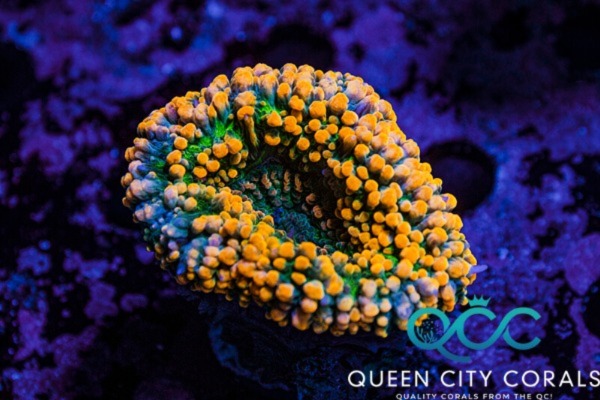
Scolymia
Scolymia corals are flat, donut-shaped looking corals that feature a rounded ridge similar to Lobophyllia.
Occasionally referred to as the donut or disk coral, this undemanding species is a popular choice for hobbyists looking for a low-maintenance coral.
Jack Frost
The "Jack Frost" coloration in corals, which is a combination of teal and purple, is displayed beautifully in this Scolymia coral. The coral is mostly purple, with streaks of teal and light blue. Under actinic lighting, the teal fluorescence is particularly striking.
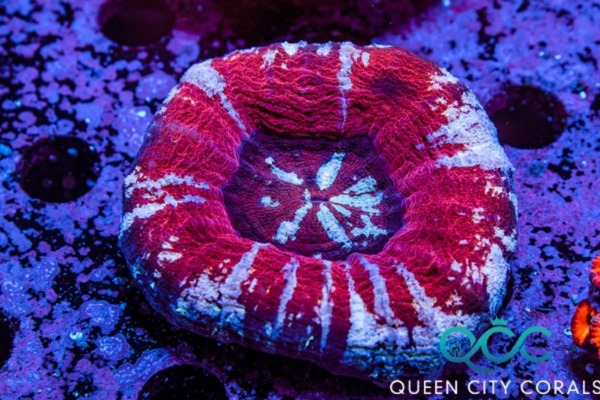
Warpaint Scolymia
The Australian Warpaint Scolymia is a highly coveted coral known for its striking appearance. Its deep purple, light blue, and orange colors make it one of the most visually impressive scolymia corals available. Due to its popularity, it is not uncommon to see these corals sell for over $200. If you are looking to add one of these unique corals to your collection, be prepared to pay a premium price for it.
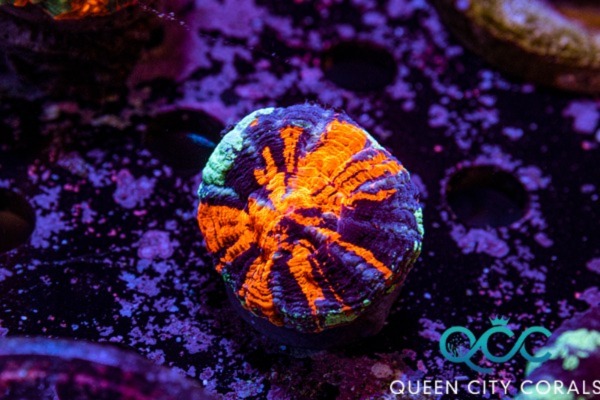
Bleeding Apple Scoly
The bleeding apple scolymia coral is a popular color variant known for its bright neon green body and distinctive orange/red radial bands. Its uniform coloration makes it an attractive choice for aquarists looking to add a scolymia coral to their reef tank.
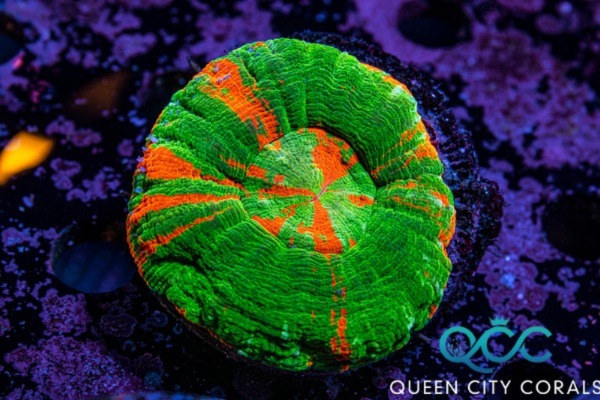
Reverse Bleeding Apple Scoly
The reverse bleeding apple scolymia coral is similar to the standard bleeding apple, but with its colors reversed. This coral has an all-orange body with neon green radial bands, creating a striking visual contrast.
Many fans of scolymia corals choose to house both the standard and reverse bleeding apple varieties in their reef aquariums to enjoy the unique beauty of each type.
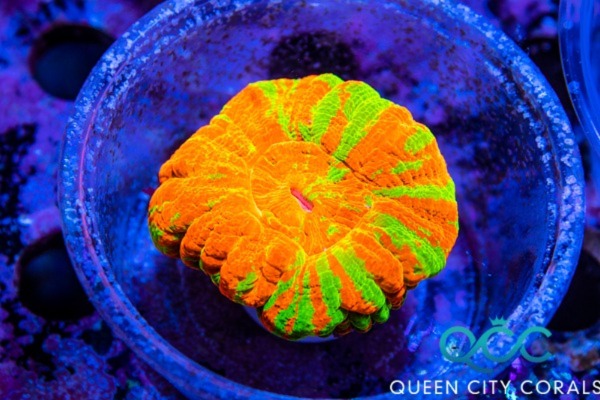
Master Scoly
Scolymia corals that display more than three colors are rare and are often referred to as "Master Scolies." These corals are highly prized by collectors due to their unique coloration and are often priced at a premium.
It is not uncommon to see Master Scolies sell for over $1000 due to their rarity. If you are interested in adding one of these exceptional corals to your collection, be prepared to pay a high price for it.
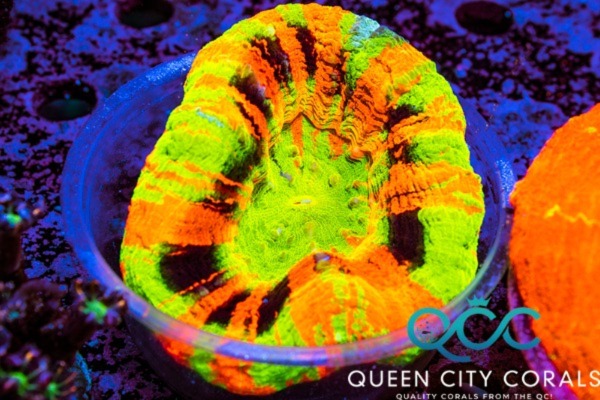
Trachyphyllia
Similar in appearance to Lobophyllia, even an experienced hobbyist can have difficulty discerning between Trachyphyllia and Lobophyllia. Trachyphyllia corals tend to have much smoother surfaces, and often display a wider variety of colors.
Rainbow Trachy
Rainbow trachyphyllia corals are known for their vibrant and varied coloration, with oranges, purples, blues, greens, and reds being among the many hues that can be displayed. Each rainbow coral exhibits its colors in unique ways, making them highly sought after by hobbyists.
These unique corals can command high prices, with some individuals willing to pay up to $400 for rainbow trachys that are only a few inches in size.
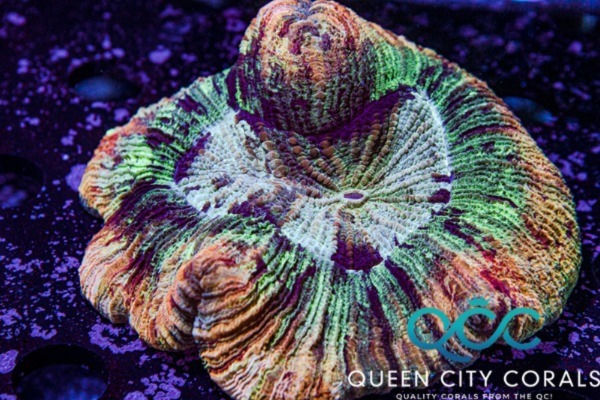
Red Ring Trachy
Red Ring Trachyphyllia corals may not have the same range of colors as rainbow trachys, but they are no less impressive. These corals resemble little fireballs, with brightly colored mouths surrounded by a donut-shaped ridge that exhibits varying shades of pink, orange, and red.
Red Ring Trachys are a stunning addition to any reef tank and are sure to catch the eye of any hobbyist.

Lime Green Trachy
Lime green trachyphyllia corals are otherworldly in appearance, with their neon green color and purple radial lines. These corals are striking and add a unique touch to any reef tank.
Lime green trachys tend to be more affordable than other Trachyphyllia species, with a price tag of around $150 for a 3-4 inch polyp being typical. If you are looking for a coral that is both affordable and visually striking, a lime green trachyphyllia may be a good choice for your reef tank.
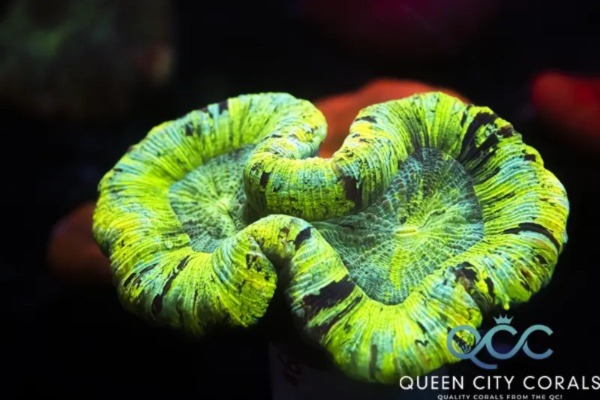
Favites
Native to the Indo-Pacific, Favites are some of the most prevalent coral species available in the hobby. These corals belong to the Merulinidae family and are typically purple, green, brown, or yellow. Similar to other brain corals, the polyps are arranged in a circular pattern around a central calyx, or depression, forming a brightly colored ridge.
The corallites of Favites are interconnected by a fused wall, and will typically have much larger polyps than the similar-looking Platygyra corals.
War Favites
War Favites are budget-friendly corals that are sure to impress hobbyists with their bright green mouths and intense red colors. These corals make an eye-catching addition to any reef tank and are easy on the wallet, with prices averaging around $30 for a coral that is a few inches in size. If you are looking for a colorful and affordable coral for your aquarium, War Favites are worth considering.
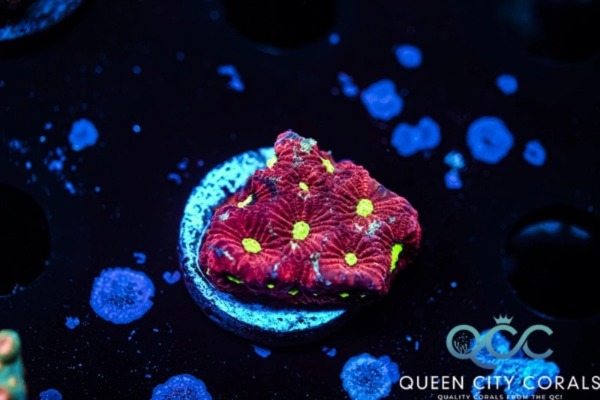
Platygyra
Platygyra corals, also known as brain worm corals, are a type of coral that is uncommon but still relatively affordable when available. These corals are known for their fragility and require careful handling to ensure their health and longevity in the aquarium. Platygyra corals are fast-growing when provided with proper conditions and have a similar appearance to Favites, but with much smaller polyps.
Green Platygyra
The Green Platygyra coral is known for its striking appearance, with purple ridges and neon green channels being among its defining features. This coral is a budget-friendly option for aquarists, with pieces that are approximately 3/4 to 1 inch in size typically selling for around $30 to $40.
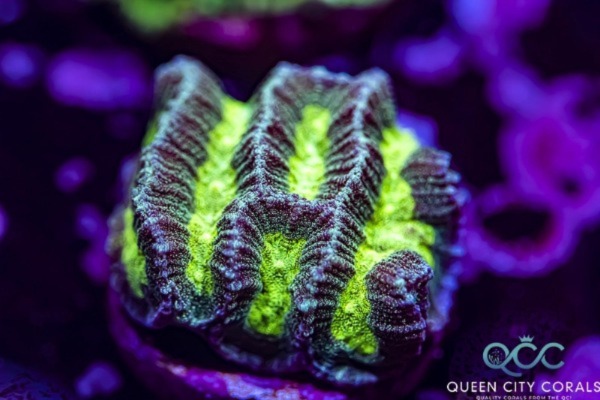
Brain Coral Care
Many brain coral species are generally easy to care for in a reef aquarium, making them a good choice for beginner hobbyists. However, it is important to remember that even though these corals may be relatively easy to care for, they still have specific requirements that must be met to ensure their health and longevity.
Decades of experience in caring for brain corals have led to a consensus on best practices, which can help hobbyists provide the best possible care for these unique species.
By following these guidelines you’ll be well-equipped to care for these interesting corals.
Tank Size
We recommend a tank between 75-100 gallons in size if you plan on keeping a brain coral.
While it is possible to keep brain corals in smaller tanks, these systems are generally less stable and require closer monitoring of water chemistry.
Larger tanks, such as those that are over 70 gallons, tend to be more stable and provide additional space for future livestock and additional coral. If your budget allows, it may be more beneficial in the long run to invest in a larger tank to ensure the health and well-being of your brain corals and any other aquarium inhabitants.
Water Parameters
To ensure the health and well-being of your brain coral, it is important to replicate the water conditions of its natural environment as closely as possible.
While there are many different types of corals that are considered "brain corals," the majority of these corals that are traded in the hobby tend to have similar care requirements. It is always a good idea to research the specific care requirements of your brain coral species, but if you cannot find specific information, you can use the following guidelines as a starting point:
Specific Gravity: 1.023-1.025
Temperature Range: 72°F-78°F
KH: 8-12 dKH
pH: 8.1-8.4
Calcium: 400 ppm
Magnesium: 1250-1350 ppm
It is important to maintain consistent water chemistry levels for the duration of your reef aquarium. In combination with a well-balanced diet, these conditions will provide your brain coral with everything it needs to thrive.
Tank Setup
Before purchasing a brain coral for your aquarium, it is important to ensure that your tank is properly set up.
You'll want to have a good understanding of the flow, placement, and lighting requirements of brain corals, as well as a properly planned hardscape and layout. Taking the time to plan your aquarium setup carefully can help prevent issues such as overcrowding and territory disputes, and is an important step in ensuring the success of your corals.
Placement
Brain corals should be placed directly on the sand bed.
To prevent potential infections, it is best to avoid placing brain corals directly on live rock, as their flesh can tear if it rubs against the rock.
Using a frag rack can also be a good option if you need to allow your coral to grow a bit before finding a permanent spot in your tank.
Lighting
Low to moderate lighting is ideal for brain corals. If you’re measuring your light intensity with a par meter , you’ll want to aim for a light intensity between 30-150 par.
Brain corals will whiten when they’re stressed, a process commonly referred to as bleaching. If you notice that your brain coral is turning white, move it to a shadier area with less light, and check to make sure that it’s getting an adequate amount of food.
Flow
Low to medium flow rates are ideal for keeping brain corals.
It is important to provide enough flow to keep detritus from accumulating on the coral, but not so much that it causes stress.
If the fleshy portion of the coral is staying close to the skeleton, this may be a sign that the flow is too strong. Too much flow can be lethal to brain corals, so it is important to carefully monitor and adjust the flow rate as needed.
Adjustable powerheads, such as those from Ecotech Marine , can help achieve the correct flow rate for your brain coral. You can also position your coral on the sand bed behind live rock to help protect it from the full force of flow from a powerhead.
Feeding
To promote the growth and development of your brain corals, we recommend spot-feeding them with amino-acid-based foods at least once a week.
Products such as Reef Roids , and Reef Energy Plus (AB)+ , will be beneficial, but it’s important to be aware that increased feedings may result in changes to phosphate levels. If you detect a spike in phosphate, you’ll want to lower your phosphate levels right away to prevent potential problems.
While it is not strictly necessary to spot-feed your corals, many aquarists report that this practice leads to better growth and increased resistance to infection.
Behavior
Brain corals are semi-aggressive, and are known to attack neighboring corals with their sweeper tentacles. These tentacles tend to appear at night and can extend up to 5 inches in length.
It’s important that you keep your brain corals far away from neighboring corals. You'll want to aim for at least a foot of space, the more space you have, the less chance you’ll experience any acts of aggression.
Fragging
Corals from the genera Trachyphyllia, Lobophyllia, and Scolymia are generally more difficult to frag than other species, but it is still possible to do. We recommend watching this video by Eric Borneman , who covers the intricacies of fragging these corals in detail.
Corals from the Favites and Platygyra genera are easier to frag than their open-brain counterparts. You’ll need proper eye care and a wet band saw to cut through the hard skeletons of these corals.
First, you’ll want to disinfect the corals in a bucket with a bit of tank water and Lugols Iodine solution .
Then, you’ll want to cut directly on the corallite walls and place them in a restorative dip, such as Brightwell Aquatics Restor for a few minutes.
After cutting, you can rinse and replenish the disinfectant buckets so that any remaining coral flesh doesn’t interact with any additional corals you plan on fragging.
Tank Mates
Brain corals can co-exist with other corals such as torches, mushrooms, and acans, but you'll need to make sure that there’s plenty of open space between them.
You should consider the growth potential and sweeper tentacle length of both the brain corals and any neighboring corals when determining the appropriate distance to leave between them. A distance of 12-20 inches is generally a good rule of thumb.
As far as livestock, any fish or invertebrates that are considered reef-safe will make a great addition to a brain coral reef tank. Some of our favorites include the kole yellow eye tang, orange spotted gobies and the pink streaked wrasse.
Although it’s uncommon, some brain corals will even host anemonefish such as the pink skunk anemonefish or snowflake clownfish.
By considering these factors and choosing compatible tankmates, you can create a thriving and harmonious reef environment for your corals!
Conclusion
Brain corals are some of the most unique and fascinating corals in the reef keeping hobby.
With the abundance of information and experience available on keeping brain corals, it is an excellent time to consider adding one to your tank.
Now that you’ve learned all about them, do you think a brain coral will be the right choice for you?
Let us know by commenting below, and be sure to check out our marketplace where other reef aquarium hobbyists trade some of the most interesting coral specimens in the hobby.
January's Giveaways on Light Fish


